Understanding the different Parts Of A Bike is crucial for cyclists of all levels. Whether you’re a complete beginner or an experienced rider, knowing the names and functions of each component will enhance your cycling experience, improve communication with mechanics, and allow you to better maintain your bicycle. This guide breaks down the anatomy of a standard bicycle, explaining each part in simple terms.
The diagram below illustrates the key components of a bicycle. For a more detailed look, continue scrolling down for in-depth explanations of each part.
Bike Frame Parts
The frame is the backbone of your bicycle, providing the structure and foundation for all other components. It’s designed to be strong, lightweight, and stiff, ensuring efficient power transfer and a comfortable ride. Traditionally crafted from steel, modern bike frames are often constructed from aluminum alloy, carbon fiber, or titanium, each offering different properties in terms of weight, strength, and ride quality.
A frameset includes the frame and the fork, working together as the core structure of the bike.
The most common frame design is the diamond frame, characterized by two triangles formed by six main tubes.
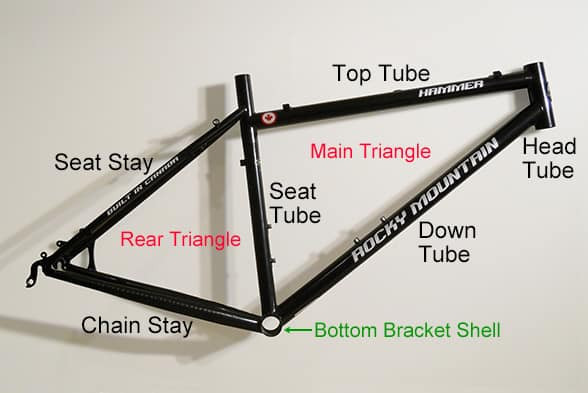 Diamond Bike Frame Anatomy
Diamond Bike Frame Anatomy
Top Tube
The top tube, sometimes called the cross-bar, is the horizontal tube that you typically swing your leg over when getting on a bike. In a traditional diamond frame, it runs roughly parallel to the ground, though some bikes feature angled or absent top tubes for easier mounting and dismounting, particularly in step-through or comfort bikes.
Head Tube
Located at the front of the frame, the head tube is a short, cylindrical tube that houses the headset. It’s the crucial connection point between the frame and the fork, enabling steering. The headset, nestled within the head tube, allows smooth rotation for turning the handlebars and front wheel.
Down Tube
The down tube is the most substantial tube on the frame, running from the head tube, just below the handlebars, down to the bottom bracket area near the pedals. Its robust nature provides significant strength to the frame. Often, you’ll find water bottle mounts and the manufacturer’s logo prominently displayed on the down tube.
Seat Tube
Extending upwards from the bottom bracket to just below the saddle, the seat tube is where the seat post is inserted. Adjusting your saddle height is done by changing how far the seat post slides into the seat tube. This allows riders of different heights to customize their bike fit.
Seat Stays
Seat stays are two slender tubes that connect the seat tube to the rear wheel hub area. They run from the upper part of the seat tube, near the saddle, down to the rear dropouts. Rear dropouts are the slots at the ends of the seat stays (and chain stays) that secure the rear wheel axle.
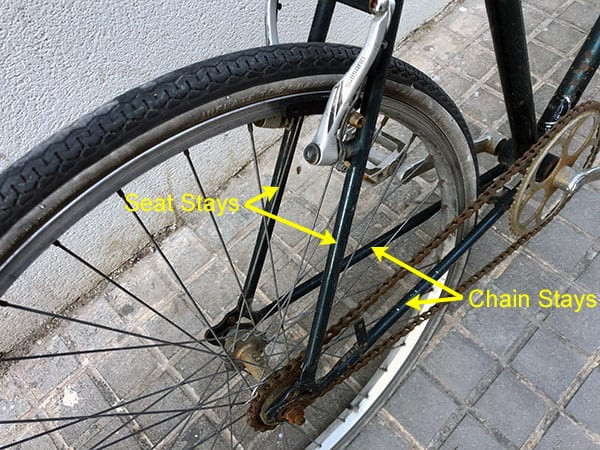 Seat Stays and Chain Stays on a Bike
Seat Stays and Chain Stays on a Bike
Chain Stays
Chain stays are two more tubes, positioned lower on the frame, running parallel to the ground from the bottom bracket area to the rear wheel dropouts. They are named chain stays because they run alongside the bike chain, from the crankset to the rear wheel.
Front of the Bike Parts
“Front of the bike parts” is a general term for the components located at the front, essential for steering, control, and braking.
Fork
The fork is the component that holds the front wheel and connects it to the frame. It has two main parts: fork blades and a steerer tube. The fork blades extend downwards on either side of the front wheel, while the steerer tube is hidden inside the head tube and connects to the headset.
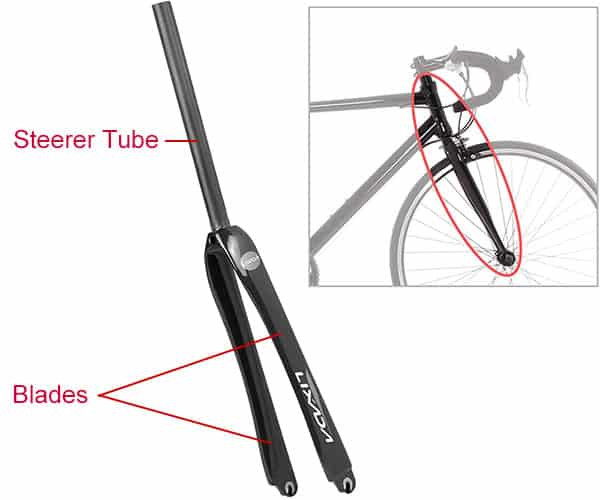 Bicycle Fork Anatomy
Bicycle Fork Anatomy
Headset
The headset is a set of bearings and races that sits inside the head tube, allowing the fork’s steerer tube to rotate smoothly within the frame. This rotation is what enables you to steer the bicycle by turning the handlebars.
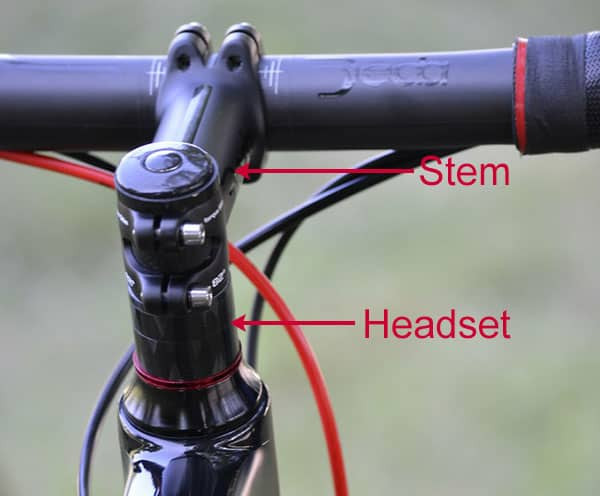 Bike Headset and Stem Connection
Bike Headset and Stem Connection
Stem
The stem is the component that bridges the gap between the fork’s steerer tube and the handlebars. It clamps onto the steerer tube at one end and the handlebars at the other, effectively extending forward from the head tube to position the handlebars for comfortable reach and control.
Handlebars
Handlebars are what you use to steer the bike and also provide a place to mount brake levers and shifters. They attach to the stem and come in various shapes and sizes, designed for different riding styles. Flat handlebars are common on mountain bikes and hybrid bikes, offering upright riding positions and good control. Drop handlebars, curving downwards, are typical of road bikes, providing multiple hand positions for comfort and aerodynamic efficiency.
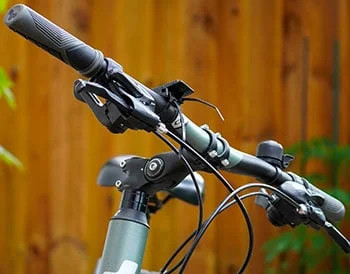 Straight Bike Handlebars
Straight Bike Handlebars
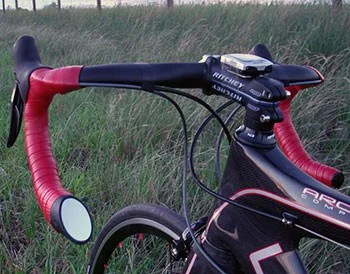 Drop Bike Handlebars
Drop Bike Handlebars
Brake Levers
Brake levers are hand-operated controls mounted on the handlebars that, when squeezed, activate the brakes to slow down or stop the bike. On some bikes, particularly those with integrated shifters, brake levers may be combined with gear shifters into units called brake shifters or brifters. Brake cables run from the levers down to the brake calipers at the wheels.
Brakes (Rim vs Disc)
Bicycle brakes come in two main types: rim brakes and disc brakes. Rim brakes operate by squeezing brake pads against the wheel rim to create friction and slow the bike. They are lightweight, generally less expensive, and easy to maintain, making them a common choice for many bikes. However, their performance can be reduced in wet or muddy conditions.
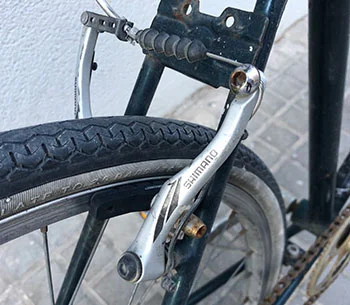 Rim Brakes on a Bicycle Wheel
Rim Brakes on a Bicycle Wheel
Disc brakes, on the other hand, use a rotor (the disc) attached to the wheel hub. Calipers squeeze brake pads against this rotor to provide braking force. Disc brakes offer more consistent performance in all weather conditions and are generally more powerful, especially in wet or muddy environments. While traditionally found on mountain bikes, disc brakes are increasingly popular across all bike types due to their reliability and stopping power.
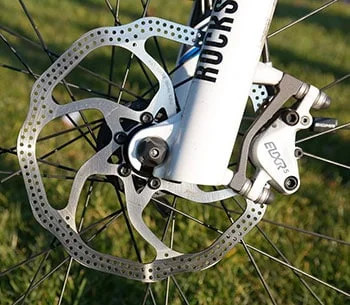 Disc Brake on a Bicycle Wheel
Disc Brake on a Bicycle Wheel
Bike Wheel Parts
Bike wheels, usually two in number (a wheelset), are crucial for rolling motion. Each wheel is composed of several key parts working together. Tricycles will have three wheels, but the components of each wheel remain similar.
Hub
The hub is the central part of the wheel, located at the axle. It’s a complex component consisting of the hub shell, bearings, and axle.
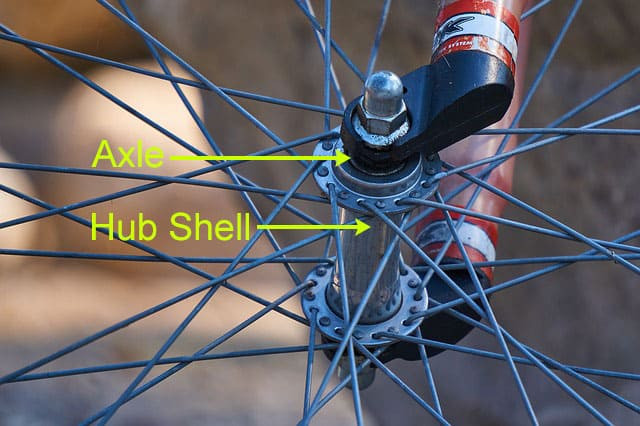 Bicycle Wheel Hub Anatomy
Bicycle Wheel Hub Anatomy
The hub shell is the outer casing to which the spokes attach. The axle is a rod that passes through the hub’s center and attaches to the frame or fork dropouts. Bearings, located between the axle and hub shell, allow the hub shell and thus the wheel to spin smoothly around the stationary axle.
Rim
The rim is the outer circular part of the wheel, forming the hoop onto which the tire is mounted. Historically made of steel, modern rims are typically constructed from aluminum alloy for lighter weight. Rims designed for rim brakes have a smooth braking surface on their sides for the brake pads to grip.
Spokes
Spokes are thin rods or wires that connect the rim to the hub. They distribute weight and tension evenly, creating a strong and resilient wheel capable of supporting the rider’s weight and withstanding riding forces. Nipples, small nuts located where the spokes meet the rim, allow for spoke tension adjustment, essential for wheel trueness.
Tire
The tire is the rubber outer covering that fits onto the wheel rim. It provides traction and cushioning, acting as the primary contact point between the bike and the riding surface. Tires are made from layers of rubber and fabric, with a thicker outer layer featuring a tread pattern for grip. Most bicycle tires are clincher tires, designed to be used with an inner tube.
Valve (Schrader vs Presta)
A valve is used to inflate or deflate the inner tube within the tire. It protrudes through a hole in the rim. Two common valve types are Schrader and Presta. Schrader valves, also found on car tires, are wider and have a spring-loaded pin. Presta valves, narrower and often with a lock nut, are more common on performance bicycles.
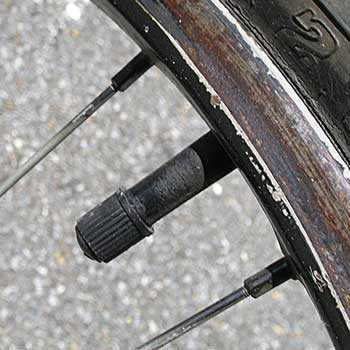 Schrader Bike Tire Valve
Schrader Bike Tire Valve
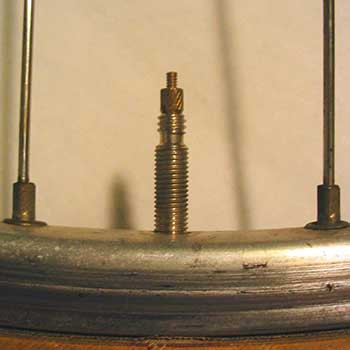 Presta Bike Tire Valve
Presta Bike Tire Valve
Back of the Bike Parts
“Back of the bike parts” refers to the components at the rear of the bike, primarily involved in propulsion and gear changing.
Crankset / Chainset
The crankset, also known as the chainset, is the assembly that your legs power to propel the bike. It consists of chainrings and crank arms. Chainrings are the toothed rings that the chain engages with – they are the front gears of the bike. A single-speed bike has only one chainring, while geared bikes can have two or three. Crank arms are the levers to which the pedals are attached.
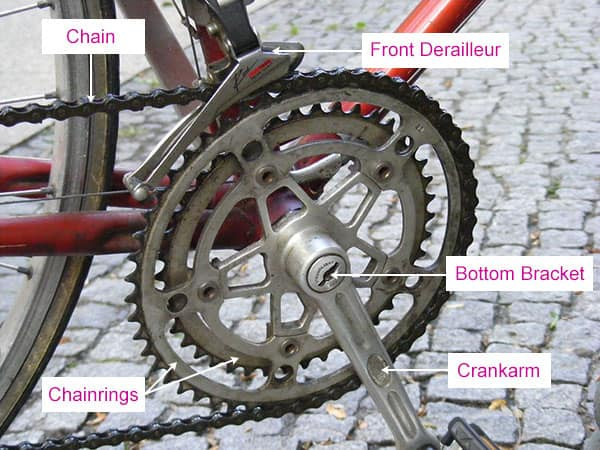 Bike Crankset and Components
Bike Crankset and Components
The crankset connects to the frame via the bottom bracket, to the rear wheel via the chain, and to the rider via the pedals, forming the core of the drivetrain.
Pedals
Pedals are the interface between your feet and the bike, allowing you to transfer power from your legs to the crankset and drive the bike forward. There are two main categories: flat pedals and clip-in pedals. Flat pedals, also called platform pedals, are simple platforms where you rest your feet. Clip-in pedals, also known as clipless pedals, require special cycling shoes with cleats that lock into the pedal mechanism, providing a more secure and efficient connection.
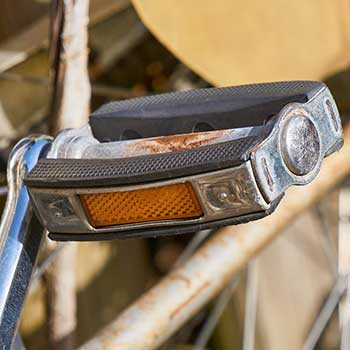 Flat Bike Pedal
Flat Bike Pedal
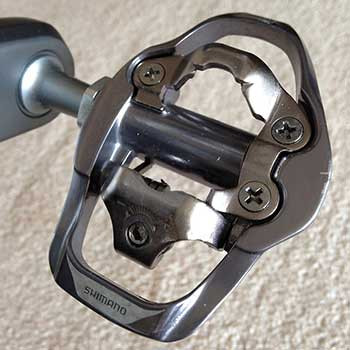 Clip-in Bike Pedal
Clip-in Bike Pedal
Bottom Bracket
The bottom bracket is the bearing assembly that allows the crank arms to rotate smoothly within the frame. It is comprised of a spindle (to which the crankset attaches) and bearings housed within the bottom bracket shell, a reinforced part of the frame at the base of the seat tube and down tube.
Chain
The chain is a loop of interconnected links that transmits power from the crankset to the rear wheel. It runs around the chainrings at the front and the cassette sprockets at the rear, moving along the chain stays.
Front Derailleur
The front derailleur is a component that shifts the chain between different chainrings on the crankset, enabling gear changes at the front. It’s only present on bikes with multiple front gears (more than one chainring).
Cassette / Cogset
The cassette, also known as a cogset, is a cluster of sprockets (cogs) of varying sizes mounted on the rear wheel hub. These cogs are the rear gears of the bike. Bikes without gears will have a single cog instead of a cassette.
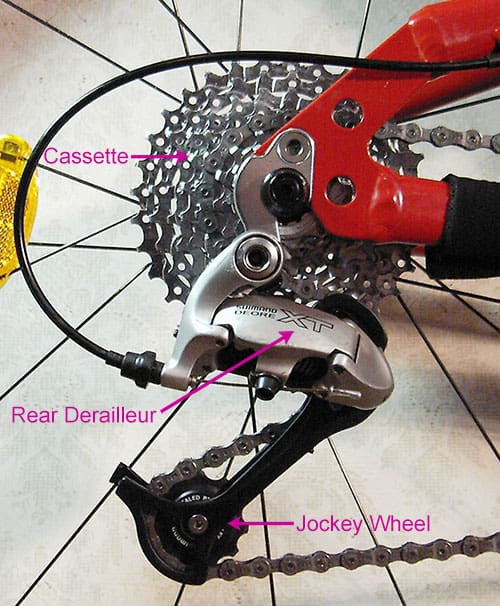 Rear Bike Derailleur and Gears
Rear Bike Derailleur and Gears
Rear Derailleur
The rear derailleur is responsible for moving the chain across the different sprockets of the cassette when you shift gears at the rear. It works in conjunction with the jockey wheel. Rear derailleurs are found on bikes with gears.
Jockey Wheel
The jockey wheel, also known as a derailleur pulley, is part of the rear derailleur. It helps to guide the chain onto different sprockets and maintains chain tension, ensuring smooth gear changes. Bikes without gears typically don’t have a jockey wheel unless it’s used as a chain tensioner on a single-speed setup.
Bike Seat Parts
Bike seat parts provide a comfortable place to sit and are crucial for rider comfort and efficiency.
Saddle
The saddle is the seat of the bicycle. Saddles come in a wide variety of shapes, sizes, and materials to suit different riding styles and rider anatomies. All saddles have saddle rails underneath, which are used to attach the saddle to the seat post using a saddle clamp.
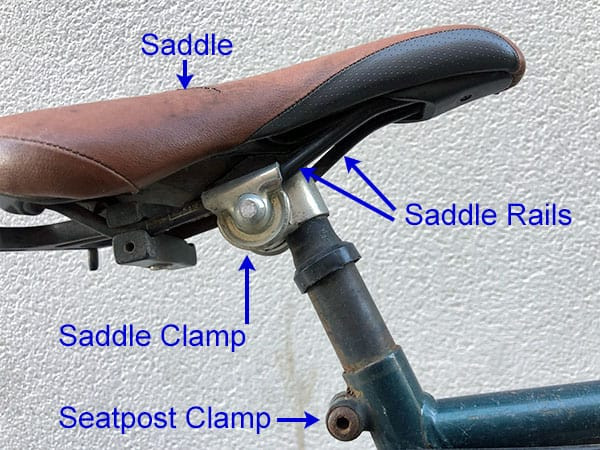 Bike Saddle Components
Bike Saddle Components
Seat Post
The seat post is a tube that inserts into the seat tube of the frame and connects to the saddle. It allows for height adjustment of the saddle. A seat post clamp located at the top of the seat tube secures the seat post at the desired height by tightening around the seat tube.
By understanding these essential parts of a bike, you’ll be better equipped to enjoy cycling, maintain your bicycle, and communicate effectively about any issues that may arise. Happy riding!
